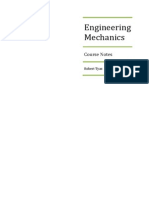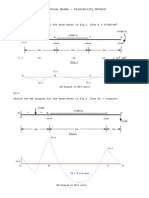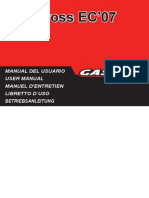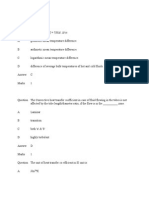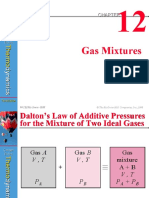Statically Indeterminate Beams
Statically Indeterminate Beams
Uploaded by
soulsellCopyright:
Available Formats
Statically Indeterminate Beams
Statically Indeterminate Beams
Uploaded by
soulsellOriginal Description:
Copyright
Available Formats
Share this document
Did you find this document useful?
Is this content inappropriate?
Copyright:
Available Formats
Statically Indeterminate Beams
Statically Indeterminate Beams
Uploaded by
soulsellCopyright:
Available Formats
Mechanics of Solids Chapter 10 STATICALLY INDETERMINATE BEAMS 10.
1 INTRODUCTION Most of the structures encountered in real-life are Statically Indeterminate. Statically Indeterminate Beams: No. of Reactions > No. of Eqns. of Equilibrium Degree of Static Indeterminacy = No. of Reactions in excess of the No. of Eqns of Equilibrium. Static Redundants = excess reactions; must be selected for each particular case. Assumption throughout this chapter is that the beams are made of Linearly Elastic Materials.
1 / 12
10.2 TYPES OF STATICALLY INDETERMINATE BEAMS Propped Cantilever Beam Ax MA Ay Fixed End Beam Ax MA Ay P Continuous Beam (more than one span) Ax A B C By A P B By Bx MB P A B
Ay There are 4 ways of solving these types of problems. 1. Use of the deflection curve 2. Moment Area Method 3. Superposition (Flexibility Method) 4. Indeterminate Beams Tables (handout) We will examine No. 1 & 3, above.
By
Cy
Mechanics of Solids Chapter 10
2 / 12
10.3 ANALYSIS BY THE DIFFERENTIAL EQUATIONS OF THE DEFLECTION CURVE 1. 2. 3. 4. 5. 6. pick redundant reaction express other reactions in terms of the redundant reaction write diff. eqn. of the deflection curve integrate to obtain general solution apply B.C. to obtain constants of integration & the redundant reaction solve for the remaining reactions using equations or equilibrium
This method is useful for: - simple loading conditions - beams of only one span (not good method for continuous beam)
Mechanics of Solids Chapter 10 EXAMPLE No. 1 GIVEN: The beam shown. A L FIND: Reactions at supports using the deflection curve. q B
3 / 12
SOLn:
Mechanics of Solids Chapter 10 OPTIONAL MOMENT AREA METHOD (just mention) 1. 2. 3. 4. 5. 6. 7. 8. pick redundant reaction(s) remove redundant reaction(s) to leave a statically determinate beam apply loads on released structure draw M / EI diagram for these loads apply redundant reactions as loads draw M / EI diagram for redundant reactions apply moment area theorems to find redundant reactions solve for remaining reactions using equations of equilibrium
4 / 12
Once reactions are determined, stresses and deflections can be calculated.
Mechanics of Solids Chapter 10 EXAMPLE No. 2 GIVEN: The beam shown. A
OPTIONAL
5 / 12
q lb / ft B L ft 2L ft
FIND: Reactions at supports using the Moment Area Method. SOLn:
Mechanics of Solids Chapter 10 10.4 METHOD OF SUPERPOSITION 1. 2. 3. 4. 5. 6. 7. 8.
6 / 12
pick redundant reaction(s) remove redundant reaction(s) to leave a statically determinate released structure determine deflections due to loads on released structure apply redundant reaction(s) as loads determine deflections due to redundant reaction(s) sum the deflections for the total deflection this is the superposition principle solve for the redundant reaction(s) solve for the remaining reaction(s) using the eqns. Of equilibrium
continuous beams:
This beam has 4 supports and 2 eqns of equilibrium. Thus there are 2 redundant forces. If all loads are vertical and there are no axial deformations, then all reactions will be vertical. The number of redundant forces is: No. of Redundant Forces = No. of Supports 2 2 Eqns of Equilibrium We can analyze continuous beams by any of the previous methods but only superposition is practical. HINT: when there are more than 2 supports, select the bending moments in the beam at the intermediate supports as the redundants. Lets see how this is done. A IA LA C IB LB
Mechanics of Solids Chapter 10 FBD
7 / 12
MA
A RA
B RBL
MB
MB
B RBR
C RC
MC
BL
BR
Because the beam is continuous across B:
BL = BR ____________ ( 1 )
SUPERPOSITION deflection due to LOADS + deflection due to REDUNDANTS BL = due to MA + due to MB + due to loads in AB ____________ ( 2a ) BR = due to MB + due to MC + due to loads in BC ____________ ( 2b )
BL due to MA:
BL1 =
MALA 6 E IA MBLB 3 E IB
due to MB: BL2 =
MBLA 3 E IA MCLB 6 E IB
Case 7 Appendix G Table G 2 Page 909
BR due to MB:
BR1 =
BR due to MC:
BR2 =
SUBSTITUTING (the above terms for BL1 , BL2 , BR1 , BR2 into EQNs ( 2a ) & ( 2b ): BL = MALA 6 E IA MBLB 3 E IB + MBLA 3 E IA MCLB 6 E IB + BL3 due to LOADS in AB _______ ( 3a )
BR =
BR3 due to LOADS in BC _______ ( 3b )
Mechanics of Solids Chapter 10 We can use 2nd Moment Area Theorem ( pg 628 ) Arclength : = L From 2nd M-A Th: EI = Ax = Ax EI L = = GENERIC Moment Diagrams for EXTERNAL LOADS: AA AB Ax EI Ax EIL
8 / 12
L L
Substituting in arclength:
xA
xB
Substituting the above terms for BL3 & BR3 into EQNs ( 3a ) & ( 3b ); using EQN ( 1 ) and rearranging:
LA L A LB LB M A I + 2M B I + I + MC I A A B B 6 AA x A 6 AB x B = I L I L A A B B
3 Moment equation If IA = IB I:
M A L A + 2M B ( L A + LB ) + M C ( LB ) =
6 AA x A 6 AB x B ___________ ( 4 ) LA LB
If LA = LB L:
M A + 4M B + M C =
6 ( AA x A + AB x B ) L2
Mechanics of Solids Chapter 10 PROCEDURE: write one 3-moment equation for each intermediate support. This provides as many equations as redundant moments. solve simultaneously for moments. ASSUMPTION MADE: The 2 extreme ends of the continuous beam were simply supported. For fixed ends, see Text Example 10 4, Pg 724. What happens if one or both are a fixed support? ANS: the number of redundant moments will be increased.
9 / 12
SOLUTION: Replace the fixed support by an additional span having an infinite moment of inertia. This prevents rotation, which is what a fixed support does. FIG 10 15 / pg 724 Moments found at points 1, 2, and 3 will be the same as in the original beam. To find remaining reactions, the equations of equilibrium must be applied to each beam section. For the example we just did; RB = RBL + RBR RBL is made up of 3 parts RBR is made up of 3 parts Must do this at each support. MA , - MB , external load LA LA MC , - MB , external load LB LB
Mechanics of Solids Chapter 10 EXAMPLE No. 1 GIVEN: The beam shown. Is are equal. 10 kN/m 1 2m R1 FIND: Reactions at supports. SOLn: 2m 2m R2 10 kN/m 2 8 kN 3 3m R3 8 kN m
10 / 12
Mechanics of Solids Chapter 10 EXAMPLE No. 2 GIVEN: The beam shown. A L 2L
11 / 12
q lb / ft
FIND: Reactions at the supports using superposition method. SOLn:
Mechanics of Solids Chapter 10 INDETERMINATE BEAM TABLES (handout)
12 / 12
You might also like
- Determinacy, Indeterminacy and Stability of StructuresNo ratings yetDeterminacy, Indeterminacy and Stability of Structures34 pages
- International Journal of Civil and Structural EngineeringNo ratings yetInternational Journal of Civil and Structural Engineering11 pages
- Two Way Slab Direct Design Method (DDM) : Eng - Loai TarabulsiNo ratings yetTwo Way Slab Direct Design Method (DDM) : Eng - Loai Tarabulsi45 pages
- Analysis of Statically Indeterminate Structures100% (3)Analysis of Statically Indeterminate Structures18 pages
- Chapter - 5 Matrix Displacement Method PDFNo ratings yetChapter - 5 Matrix Displacement Method PDF31 pages
- Perbandingan Strain Energy-Virtual Work-CastiglianoNo ratings yetPerbandingan Strain Energy-Virtual Work-Castigliano36 pages
- Ch07 Distributed Forces Centroids and Centers of Gravity 2No ratings yetCh07 Distributed Forces Centroids and Centers of Gravity 257 pages
- Statically Determinant Structure PDF FreeNo ratings yetStatically Determinant Structure PDF Free21 pages
- CE 370-Lecture-12 (Design of Doubly Reinforced Beam Sections) (Read-Only) PDFNo ratings yetCE 370-Lecture-12 (Design of Doubly Reinforced Beam Sections) (Read-Only) PDF29 pages
- Fig. 8.5.2a-Typical Stirrup Shapes For Girders and Beams. Fig. 8.5.2b-Typical Stirrup Shape For Joists, in Addition To Fig. 8.5.2aNo ratings yetFig. 8.5.2a-Typical Stirrup Shapes For Girders and Beams. Fig. 8.5.2b-Typical Stirrup Shape For Joists, in Addition To Fig. 8.5.2a4 pages
- Determinate and Indeterminate Structures and Their DIfferencesNo ratings yetDeterminate and Indeterminate Structures and Their DIfferences10 pages
- Professional Training Report in STRUCTURAL ANALYSISNo ratings yetProfessional Training Report in STRUCTURAL ANALYSIS18 pages
- Numerical Methods and Implementation in Geotechnical Engineering – Part 1From EverandNumerical Methods and Implementation in Geotechnical Engineering – Part 1No ratings yet
- Electron Beam-Specimen Interactions and Simulation Methods in MicroscopyFrom EverandElectron Beam-Specimen Interactions and Simulation Methods in MicroscopyNo ratings yet
- 1.creating Label Containing National Code Parameters of MemberNo ratings yet1.creating Label Containing National Code Parameters of Member9 pages
- 7 - Swedish Experience From EC4-2 - Robert - HällmarkNo ratings yet7 - Swedish Experience From EC4-2 - Robert - Hällmark22 pages
- Microsoft Word - Lektion-Se 13267 Words BingoNo ratings yetMicrosoft Word - Lektion-Se 13267 Words Bingo1 page
- Microsoft Word - Lektion-Se 13163 DiscussNo ratings yetMicrosoft Word - Lektion-Se 13163 Discuss7 pages
- Microsoft Word - Lektion-Se 12902 Irregular VerbsNo ratings yetMicrosoft Word - Lektion-Se 12902 Irregular Verbs1 page
- Microsoft Word - Lektion-Se 12844 Regelbundna VerbNo ratings yetMicrosoft Word - Lektion-Se 12844 Regelbundna Verb3 pages
- Microsoft Word - Lektion-Se 12630 ENGLISH GRAMMAR FacitNo ratings yetMicrosoft Word - Lektion-Se 12630 ENGLISH GRAMMAR Facit8 pages
- Theorem of Three Moments - Wikipedia, The Free EncyclopediaNo ratings yetTheorem of Three Moments - Wikipedia, The Free Encyclopedia3 pages
- Shear and Moment Diagrams - Including The 3 Moment Equation and Examples100% (7)Shear and Moment Diagrams - Including The 3 Moment Equation and Examples300 pages
- 29.voltage Flicker Compensation Using STATCOMNo ratings yet29.voltage Flicker Compensation Using STATCOM6 pages
- October 2015 Question Paper 2 - tcm143 354031100% (1)October 2015 Question Paper 2 - tcm143 35403116 pages
- System of Units - MKS, CGS and SI - Karnataka PCS Free Notesyhty PDFNo ratings yetSystem of Units - MKS, CGS and SI - Karnataka PCS Free Notesyhty PDF11 pages
- Ee304.01 Energy Conversion: About The CourseNo ratings yetEe304.01 Energy Conversion: About The Course5 pages
- Time Varying Fields and Maxwell's EquationsNo ratings yetTime Varying Fields and Maxwell's Equations14 pages
- Revision Notes On Kinetic Theory of GasesNo ratings yetRevision Notes On Kinetic Theory of Gases6 pages
- School of Electrical, Electronics and Computer Engineering: EE101L/B6No ratings yetSchool of Electrical, Electronics and Computer Engineering: EE101L/B69 pages
- By Dr. Mohammed Ramidh: Engineering Materials DesignNo ratings yetBy Dr. Mohammed Ramidh: Engineering Materials Design114 pages
- Fluid Mechanics (2) : Dr. Ali Mahmoud Ali Attia ME 413No ratings yetFluid Mechanics (2) : Dr. Ali Mahmoud Ali Attia ME 4137 pages
- Determinacy, Indeterminacy and Stability of StructuresDeterminacy, Indeterminacy and Stability of Structures
- International Journal of Civil and Structural EngineeringInternational Journal of Civil and Structural Engineering
- Two Way Slab Direct Design Method (DDM) : Eng - Loai TarabulsiTwo Way Slab Direct Design Method (DDM) : Eng - Loai Tarabulsi
- Perbandingan Strain Energy-Virtual Work-CastiglianoPerbandingan Strain Energy-Virtual Work-Castigliano
- Ch07 Distributed Forces Centroids and Centers of Gravity 2Ch07 Distributed Forces Centroids and Centers of Gravity 2
- CE 370-Lecture-12 (Design of Doubly Reinforced Beam Sections) (Read-Only) PDFCE 370-Lecture-12 (Design of Doubly Reinforced Beam Sections) (Read-Only) PDF
- Fig. 8.5.2a-Typical Stirrup Shapes For Girders and Beams. Fig. 8.5.2b-Typical Stirrup Shape For Joists, in Addition To Fig. 8.5.2aFig. 8.5.2a-Typical Stirrup Shapes For Girders and Beams. Fig. 8.5.2b-Typical Stirrup Shape For Joists, in Addition To Fig. 8.5.2a
- Determinate and Indeterminate Structures and Their DIfferencesDeterminate and Indeterminate Structures and Their DIfferences
- Professional Training Report in STRUCTURAL ANALYSISProfessional Training Report in STRUCTURAL ANALYSIS
- Numerical Methods and Implementation in Geotechnical Engineering – Part 1From EverandNumerical Methods and Implementation in Geotechnical Engineering – Part 1
- Electron Beam-Specimen Interactions and Simulation Methods in MicroscopyFrom EverandElectron Beam-Specimen Interactions and Simulation Methods in Microscopy
- 1.creating Label Containing National Code Parameters of Member1.creating Label Containing National Code Parameters of Member
- 7 - Swedish Experience From EC4-2 - Robert - Hällmark7 - Swedish Experience From EC4-2 - Robert - Hällmark
- Microsoft Word - Lektion-Se 12844 Regelbundna VerbMicrosoft Word - Lektion-Se 12844 Regelbundna Verb
- Microsoft Word - Lektion-Se 12630 ENGLISH GRAMMAR FacitMicrosoft Word - Lektion-Se 12630 ENGLISH GRAMMAR Facit
- Theorem of Three Moments - Wikipedia, The Free EncyclopediaTheorem of Three Moments - Wikipedia, The Free Encyclopedia
- Shear and Moment Diagrams - Including The 3 Moment Equation and ExamplesShear and Moment Diagrams - Including The 3 Moment Equation and Examples
- System of Units - MKS, CGS and SI - Karnataka PCS Free Notesyhty PDFSystem of Units - MKS, CGS and SI - Karnataka PCS Free Notesyhty PDF
- School of Electrical, Electronics and Computer Engineering: EE101L/B6School of Electrical, Electronics and Computer Engineering: EE101L/B6
- By Dr. Mohammed Ramidh: Engineering Materials DesignBy Dr. Mohammed Ramidh: Engineering Materials Design
- Fluid Mechanics (2) : Dr. Ali Mahmoud Ali Attia ME 413Fluid Mechanics (2) : Dr. Ali Mahmoud Ali Attia ME 413



























